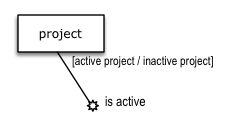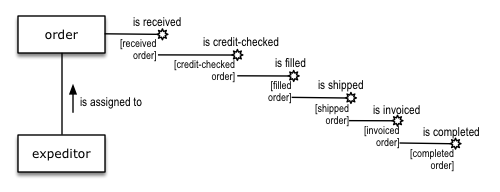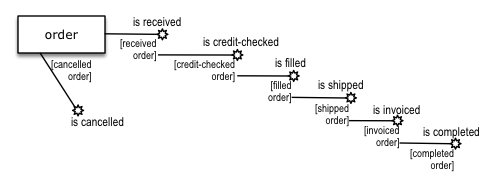ConceptSpeak™ (Part 5): Representing the States of Things
Speaking the Language of the Business with Concept Models
A concept model comprises a set of concepts and the structural relations between those concepts. ConceptSpeak™ is a comprehensive and carefully-coordinated set of guidelines and techniques for designing a concept model.[1] The conventions of ConceptSpeak follow the Object Management Group's (OMG's) Semantics of Business Vocabulary and Business Rules (SBVR).[2] In this in-depth series, Ron Ross presents ConceptSpeak's highly-disciplined approach for creating concept models based on well-defined elements of structure.
In the previous parts of this series[3] we've explored the various ways a concept model comprises a set of concepts and the structural relations between those concepts. We haven't given any attention to transformations that things can undergo — because for the most part, that's a matter for process or other forms of models.
But things can change over time, often in predictable fashion. That is, their state can change. Metamorphosis in insects is a good example. Even if the change in state is profound, the bug is still the very same bug. The bug is not classified or categorized as something new.
Transformations in state in concept models are handled by putting together elements we've learned about already: unary verb concepts and verb-based roles.
Simple States
In this series, we've explored the various ways a concept model comprises a set of concepts and the structural relations between those concepts. So far, we've been looking at what things mean, and statements about things, from a point-in-time perspective. But in business, as in life, things can change over time. Metamorphosis in insects is a good example of transformation in state. Even if the change in state is profound, the bug is still the very same bug. The bug is not classified or categorized as something new.
Transformations in state in concept models are handled by putting together elements we've learned about already: unary verb concepts and verb-based roles.
Simple States
Consider the simple case of a project: A project might be considered active while things are happening; while things are not happening, the project might be considered inactive. A given project is either one or the other at a point-in-time — it cannot be both active and inactive simultaneously. But over time any given project might go in and out of the active state many times. In other words, the transition might not be just once.

Figure 1. Concept model diagram of simple states.
Note on ConceptSpeak Notation
This concept model diagram presents role names both for when the qualification implicit in the unary verb concept is true (active project) and for when it is not true (inactive project), respectively.
Coordinated States
Transformations in state often involve many more possibilities than the simple in-or-out states illustrated above. Specifically, entire sets of states can be identified in business communication that need to be coordinated. Consider the following business rule pertaining to orders for products. It refers to two states of order: shipped and invoiced.[4]
Business rule: An expeditor must be assigned to an order shipped but not invoiced for more than a week.
Careful examination of potential changes in the state of orders might reveal the series of states illustrated diagrammatically in Figure 2. Here only 'happy' states are represented — ones that are desirable and move the state of an order toward a desirable result. (We'll get to 'unhappy' states momentarily.) The concept model now provides the basis for a complete and integrated vocabulary to communicate about the 'happy' states of order.

Figure 2. Concept model diagram of the 'happy' states of orders.
Note on ConceptSpeak Notation
In this concept model diagram, the unary verb concept representing each successive state for order is shown as based on the verb-based role for the previous verb concept in the series. For example, the unary verb concept is credit-checked is based on the verb-based role received order, which will apply only if the unary verb concept is received is true for an order. In effect the six states shown are therefore cumulative for any given order. The next successive state can apply only if all the previous states currently apply.
Unfortunately, unhappy states do happen. 'Unhappy' states are ones that are not desirable and do not move the state of an order toward a desirable result. For example, consider the following business rule, which refers to the unhappy state cancelled.
Business Rule: A cancelled order must not have been shipped.

Figure 3. Concept model diagram of an 'unhappy' state of orders.
Note on ConceptSpeak Notation
Since 'unhappy' states can interrupt the progression of a thing through a series of 'happy' states, they are best treated separately, as illustrated in the concept model diagram above.
As illustrated, the vocabulary for transformations in state for a thing can be a rich one.[5] There are even more possibilities than illustrated here — for example, states such as back-ordered might only temporarily disrupt progression toward a desirable outcome. In addition, effective coordination of orders is likely to require specific memory about each and every transformation in state over time.
How far do you need to take your concept model toward completeness in handling transformations in the state of things and related memory? Stay within scope, but go as far as you need to express relevant knowledge and to disambiguate business communication.
References / Notes
[1] Extracted from Business Knowledge Blueprints: Enabling Your Data to Speak the Language of the Business, by Ronald G. Ross, 2020.
http://brsolutions.com/business-knowledge-blueprints.html![]()
[2] Refer to the SBVR Insider section of BRCommunity.com for more information about SBVR. SBVR was initially published in January 2008 by the Object Management Group (OMG). Its central goal is to enable the full semantics of business communication (including business rules) to be captured, encoded, analyzed for anomalies, and transferred
between machines.![]()
[3] Ronald G. Ross , "ConceptSpeak™ (Part 4): Nouns Based on Verbs — Objectifications & Roles," Business Rules Journal, Vol. 22, No. 4, (Apr. 2021)
URL: http://www.brcommunity.com/a2021/c065.html![]()
[4] States like shipped and invoiced represent
completed actions. In English, a completed action is
usually expressed using a past participle, a verb with an
added -ed, -d, -t, -en, or –n at the end. This special verb
form also allows verbs to be used as adjectives — e.g., shipped order and invoiced order. Such designations are
particularly good for verb-based roles.
Business communication sometimes refers to an ongoing
action as a state — e.g., A person must not smoke while filling a gas tank. Here the present participle filling refers to an
action in progress. ![]()
[5] For a continuation of the discussion of the considerations when including transformations in a concept model, see Chapter 14 "Verbs and Transformations" in Business Knowledge Blueprints (op cit). ![]()
# # #
About our Contributor:
Online Interactive Training Series
In response to a great many requests, Business Rule Solutions now offers at-a-distance learning options. No travel, no backlogs, no hassles. Same great instructors, but with schedules, content and pricing designed to meet the special needs of busy professionals.










How to Define Business Terms in Plain English: A Primer
How to Use DecisionSpeak™ and Question Charts (Q-Charts™)
Decision Tables - A Primer: How to Use TableSpeak™
Tabulation of Lists in RuleSpeak®: A Primer - Using "The Following" Clause
Business Agility Manifesto
Business Rules Manifesto
Business Motivation Model
Decision Vocabulary
[Download]
[Download]
Semantics of Business Vocabulary and Business Rules